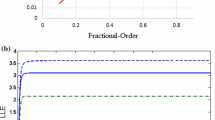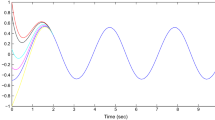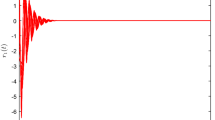Abstract
Ultra-low-voltage sinh-domain implementation of delayed inertial neuron is introduced in this paper. The complex dynamical behavior of the neuron has been verified using three different activation functions, namely tanh, unipolar sigmoidal and bipolar sigmoidal. The networks containing two and four neurons have been designed, and their complex dynamical behavior has also been verified. The proposed implementation vis-à-vis the already reported designs offers the benefits of: (1) low-voltage operation, (2) integrability, due to resistor-less design and the employment of only grounded components, (3) electronic tunability of performance parameters by external currents, which adds flexibility to the proposed designs even after their final fabrication, (4) absence of inductors as, in contrast to reported designs, the delay has been implemented using component substitution method where inductors have been replaced by emulated inductors and (5) low-power implementation due to the inherent class AB nature of sinh-domain technique. Besides, for the first time, the complex dynamical behavior of four-neuron delayed inertial network has been implemented and its functioning for different activations functions has been considered and verified. HSPICE simulator tool and TSMC 130 nm CMOS process were used to evaluate and verify the correct functioning of the model.


























Similar content being viewed by others
References
Schuman CD, Potok TE, Patton RM, Birdwell JD, Dean ME, Rose GS, Plank JS (2017) A survey of neuromorphic computing and neural networks in hardware. ArXiv: http://arxiv.org/abs/1705.06963 [cs.NE]
Devi R, Jha RK, Gupta A, Jain S, Kumar P (2017) Implementation of intrusion detection system using adaptive neuro-fuzzy inference system for 5G wireless communication network. Int J Electron Commun (AEÜ) 74:94–106
Hilal HA (2017) Neural networks applications for CDMA systems in non-Gaussian multi-path channels. Int J Electron Commun (AEÜ) 73:150–156
Bersini H, Sener P (2002) The connections between the frustrated chaos and the intermittency chaos in small Hopfield networks. Neural Netw 15:1197–1204
Tiancai W, Xing H, Tingwen H (2016) Complex dynamical behavior of neural networks in circuit implementation. Neucom 190:95–106. https://doi.org/10.1016/j.neucom.2016.01.030
Neves G, Cooke SF, Bliss TVP (2008) Synaptic plasticity, memory and the hippocampus: a neural network approach to causality. Nat Rev Neurosci 9:65–75
Mishra S, Bhende CN, Panigrahi BK (2007) Detection and classification of power quality disturbances using S-transform and probabilistic neural network. Power Deliv IEEE Trans 23:280–287
Mazurowski MA, Habas PA, Zurada JM et al (2008) Training neural network classifiers for medical decision making: the effects of imbalanced datasets on classification performance. Neural Netw 2:427–436
Tsai CF, Wu JW (2008) Using neural network ensembles for bankruptcy prediction and credit scoring. Expert Syst Appl 34:2639–2649
Li Q, Yang XS, Yang F (2005) Hyperchaos in Hopfield-type neural networks. Neucomputing 67:275–280
Khalil HK (2002) Nonlinear systems, 3rd edn. Pearson, London. ISBN 0-13-067389-7
Li C, Chen G, Liao X, Yu J (2004) Hopf bifurcation and chaos in a single inertial neuron model with time delay. Eur Phys J B Condens Matter Complex Syst 41:337–344
Wheeler DW, Schieve WC (1997) Stability and chaos in an inertial two-neuron system. Phys D 105:267–284
Koch C (1984) Cable theory in neurons with active, linearized membranes. Biol Cybern 50:15–33
Ashmore JF, Attwell D (1985) Models for electrical tuning in hair cells. Proc R Soc Lond B 226:325–334
Angelaki DE, Correia MJ (1991) Models of membrane resonance in pigeon semicircular canal type II hair cells. Biol Cybernet 65:1–10
Mauro A, Conti F, Dodge F, Schor R (1970) Subthreshold behavior and phenomenological impedance of the squid giant axon. J Gen Physiol 55:497–523
Babcock KL, Westervelt RM (1987) Dynamics of simple electronic neural networks. Phys D 28:305–316
Tani J, Fujita M (1992) Coupling of memory search and mental rotation by a non-equilibrium dynamics neural network. IEEE Trans Fundam Electron Commun Comput Sci 75:578–585
Liao XF, Wong KW, Wu ZF (2003) Asymptotic stability criteria for a two-neuron network with different time delays. IEEE Trans Neural Netw 14:222–227
Liao XF, Wong KW, Leung CS, Wu Z (2001) Hopf bifurcation and chaos in a single delayed neuron equation with non-monotonic activation function. Chaos Solitons Fractals 12:1535–1547
Liu Q, Liao X, Guo S, Xu Y (2009) Stability of bifurcating periodic solutions for a single delayed inertial neuron model under periodic excitation. Nonlinear Anal RWA 10:2384–2395
He X, Li C, Shu Y (2012) Bogdanov–Takens bifurcation in a single inertial neuron model with delay. Neurocomputing 89:193–201
Liu Q, Liao X, Liu Y, Zhou S, Guo ST (2009) Dynamics of an inertial two-neuron system with time delay. Non Linear Dyn 58:573–609
Ge J, Xu J (2013) Stability switches and fold–Hopf bifurcations in an inertial four-neuron network model with coupling delay. Neurocomputing 110:70–79
Wu ZG, Lam J, Su H, Chu J (2012) Stability and dissipativity analysis of static neural networks with time delay. IEEE Trans Neural Netw Learn Syst 23:199–210
Chen B, Chen J (2016) Global \(O\left( {t - \alpha } \right)\)stability and global asymptotical periodicity for a non-autonomous fractional-order neural networks with time-varying delays. Neural Netw 73:47–57
Khanday FA, Kant NA, Dar MR, Zulkifli TZA, Psychalinos C (2018) Low-voltage low-power integrable CMOS circuit implementation of integer- and fractional-order FitzHugh–Nagumo neuron model. IEEE Trans Neural Netw Learn Syst. https://doi.org/10.1109/tnnls.2018.2877454
Khanday FA, Dar MR, Kant NA, Rossello JL, Psychalinos C (2018) 0.65 V integrable electronic realization of integer- and fractional-order Hindmarsh–Rose (HR) neuron model using companding technique. IET Circ Dev Syst 12:696–706. https://doi.org/10.1049/iet-cds.2018.5033
Lundstrom BN, Higgs MH, Spain WJ, Fairhall AL (2008) Fractional differentiation by neocortical pyramidal neurons. Nat Neurosc 11:1335–1342
Duan SK, Liao XF (2007) An electronic implementation for Liao’s chaotic delayed neuron model with non-monotonous activation function. Phys Lett A 369:37–43
Kant NA, Dar MR, Khanday FA, Psychalinos C (2017) Ultra low voltage integrable electronic realization integer and fractional order Liao’s chaotic delayed neuron model. Circuits Syst Signal Process 36:4844–4868. https://doi.org/10.1007/sooo34-017-06515-5
Hrubos Z, Gotthans T, Petrzela J (2011) Circuit realization of the inertial neuron. In: 21st international conference radioelektronika, 19–20 April 2011. IEEE, Brno, Czech Republic. https://doi.org/10.1109/radioelek.2011.5936435
Kant NA, Dar MR, Khanday FA (2015) An ultra-low-voltage electronic implementation of inertial neuron model with non-monotonous Liao’s activation function. Netw Comput Neural Syst 26:116–135
Wang T, He X, Huang T (2016) Complex dynamical behavior of neural networks in circuit implementation. Neurocomputing 190:95–106
Song ZG, Xu J (2012) Stability switches and multistability coexistence in a delay-coupled neural oscillators system. J Theor Biol 313:98–114
Liao X, Li S, Chen G (2004) Bifurcation analysis on a two-neuron system with distributed delays in the frequency domain. Neural Netw 17:545–561
Khodabandehloo G, Mirhassani M, Ahmadi M (2012) Analog implementation of a novel resistive-type sigmoidal neuron. IEEE Trans VLSI Syst 20:750–754
Khuder AI, Husain SH (2013) Hardware realization of artificial neural networks using analogue devices. Al Rafidain Eng 21:77–90
Kant NA, Khanday FA, Psychalinos C (2014) 0.5 V Sinh-domain design of activation functions and neural networks. ASP J Low Power Electron 10:201–203
Kontogiannopoulos N, Psychalinos C (2005) Log-domain filtering by simulating the topology of passive prototypes. IEEE Trans Circuits Syst I 52:2043–2054
Acknowledgements
This work was supported by Science and Engineering Research Board (SERB), Department of Science and Technology (DST), Government of India, under the Extra Mural Research (EMR) Scheme (EMR/2016/007125).
Author information
Authors and Affiliations
Corresponding author
Ethics declarations
Conflict of interest
The authors declare that they have no conflict of interest.
Additional information
Publisher's Note
Springer Nature remains neutral with regard to jurisdictional claims in published maps and institutional affiliations.
Rights and permissions
About this article
Cite this article
Khanday, F.A., Dar, M.R., Kant, N.A. et al. Ultra-low-voltage integrable electronic implementation of delayed inertial neural networks for complex dynamical behavior using multiple activation functions. Neural Comput & Applic 32, 8297–8314 (2020). https://doi.org/10.1007/s00521-019-04322-6
Received:
Accepted:
Published:
Issue Date:
DOI: https://doi.org/10.1007/s00521-019-04322-6




